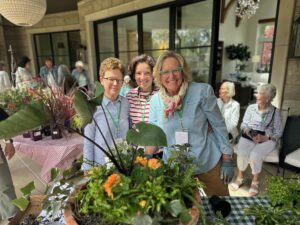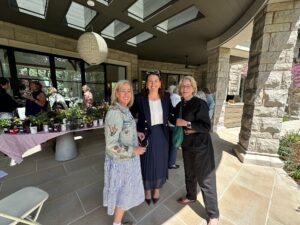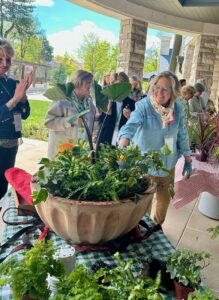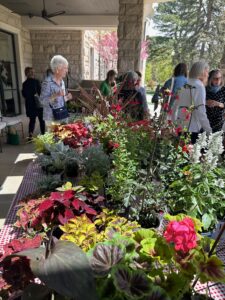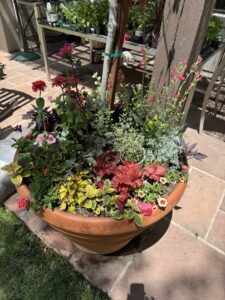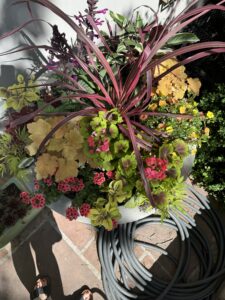Mary F and Lise W. made this presentation at the May meeting.
Preparation
Kinds of Pots: Terra Cotta (lovely to look at, but don’t leave out in the winter without removing all soil, they tend to spall with age, and you get what you pay for – look for a smooth texture and heft), Concrete & Glazed (sturdier, can overwinter with soil, different aesthetic), Plastic (meh, cheaper, breaks down in the sun, who needs more plastic?). Size matters. Smaller pots will dry out faster, especially in our sun. I don’t use anything smaller than 24” unless it’s in the shade.
Plants
Any plant, seedling or otherwise, whether it comes from inside a house or a nursery, if it has not spent time outdoors, it needs to be hardened off before planting. Hardening off is the process of gradually exposing plants to outdoor conditions, allowing the plant cuticle wall to thicken, which protects it from UV rays and damaging moisture loss. I don’t let any plant, whether it’s going in a pot or into the garden, have direct sunlight until it gets two full days and nights outside and under shade. Tenderer annuals will often need to be brought back inside at night if the temps dip below 38-42 degrees. I have also ruined a lot of unplanted container plants by not keeping them moist in the tiny pots they come in. I start buying at the end of April, and usually wait until after Mother’s Day to plant the pots, so that’s a lot of special attention that has to be paid in the interim.
Potting Soil
Some people make their own mixture. [Anyone?] I tried using the industrially composted mixtures for containers, but they didn’t hold moisture at all. I’ve used Fertilome the past two years and that’s worked okay, but they add a petroleum-based fertilizer, which I try not to use. I’m still looking for container soil Nirvana – this year, I am trying Echter’s hand mixed outdoor container soil. No added fertilizer, but does have a wetting agent, a must, I think, for our hot dry summers. Note: Potting soils for succulents or alpine plants in troughs are specialized for the needs of those plants. Consult with your nursery of choice.
Filling containers
Cover holes in the bottom with pot shards. Make sure the hole is well covered. Potting soil can drift down through openings and then plug the whole container, stopping drainage and drowning your plants. Don’t overfill with soil initially. Water the soil before planting. Planting in dry potting soil and then watering after planting tends to push the root balls up. Leave yourself a good 2-4 inches from the top in large pots when planting is done, less with smaller containers so that you can water without spilling water and soil out of the top of the pot. If you have really large pots, it’s not necessary to fill them completely with soil . You can use upside down smaller plastic pots or bubble wrap or packing peanuts in a plastic bag to fill the bottom and decrease the amount of soil needed. If you have tall skinny pots, load the bottoms down with rocks or gravel or they will go down in a good Colorado wind.
Buying and Planting Tips
Flowering annuals are the workhorses for container planting, because they are showy and tend to bloom all summer (although some need regular deadheading, like lantana, verbenas and any daisy-like plants). Definitely don’t confine yourself, though, to the annuals section of a nursery when you’re shopping for container plants. Look in the houseplant/tropicals section, look at grasses, vines, ferns, veggies or herbs, shrubs, small trees or topiaries, being sure to note which plants prefer sun or shade.. As the summer goes on, some annuals will give up the ghost and then you can shop for seasonal perennials coming into bloom or leftover annuals, often marked down drastically by nurseries as the season progresses. If you are buying four or six- packs of plants, make sure that every plant is alive and viable in the pack (ie. not broken or just about to expire). I have no problem with pulling a dead plant out and replacing it with one from another pack right at the nursery. Also, anything you plant in a container that is perennial can come out of the container and into the garden in the fall.
I generally arrange the plants in the pot before I take them out of their plastic, then take a picture and pull them out again. Some smaller or trailing plants look better in groups, which makes a bigger impact.I start in the middle and move outward. Don’t put the tallest plant in the middle of the pot. Offset it and cluster with other taller plants. I’m a Darwinist when it comes to plants. I cut off the root-bound bottoms completely, I deeply score the sides if they are rootbound. I smash them into the soil and cram them close. We only have the summer together and I’m looking for a brief but spectacular relationship.
I have the best luck buying container plants at Echters, Nick’s (look for the smallest container you can buy), City Floral and the Flower Bin. The last one is in Longmont, which is a long drive, but my dogs get groomed about halfway there and I think they have the BEST selection of perennials for the garden, so that’s how I justify the larger carbon footprint. They also don’t use neonics, so hurray for the bees!
There are also tons of pop-up garden centers in the summer in random locations that will always have the basics. You can find lots of stuff at Home Depot and Lowes, but be sure to buy them right after they get unloaded from the trucks, ‘cause after that, it’s all downhill for those poor plants…
What to plant? The fun stuff
For color. Most flowering annuals are by definition colorful and I’ll have a list of my favorites on the website and you can see lots of them here.
There are a couple I am missing because they hadn’t arrived in the nursery. Abutilon. chocolate cosmos, the fancier rex begonias. But the more I’ve done this, the more I am drawn to foliage and variegation and grasses to supplement the flowers, because they also add texture and contrast. Draceanas, phormiums, cordyline, purple fountain grass, sedges and blue fescue are good examples of colorful grasses.
For foliage, there are many colorful varieties of heucheras (coral bells). Helichrysums (licorice plant) can be lime green, silver or variegated and can also function as trailing plants. Plectranthus (swedish ivy) comes in a lime colored variety and my favorite, Troy’s Gold. I’ve used blue cabbage, which is a fabulous big plant, loved by slugs and cabbage moths, so take steps to discourage them. Coleus. ipomea or sweet potato vine – right lime green, black, coppery red-brown. Variegated (pineapple) and purple sage. Geraniums like Mrs. Pollack, Vancouver Centennial, Brocade Fire and Bull’s-Eye Salmon. Your mother’s silver dusty miller plant now comes with different leaf varieties, or look for Centaurea for a bigger bang. Go for various shades of green and don’t forget plants that provide good contrasts in brown and black (oxalis, some cannas, heucheras, alternatheras). There are all sorts of interesting and colorful tropical plants that will do fine in a shady spot. They can all come inside before frost and be tended and reused the next summer or re-gifted to unsuspecting hostesses at Thanksgiving, Christmas and New Year’s.
For texture and height. What do I mean by texture? Spiky, ferny, fuzzy, shrubby, trailing, big vs. small leaves, unique leaves (like this Colocasia or Coffee Cup Plant). Foliage versus flowers. For height, you can buy tall plants, duh. Grasses, cannas, phormiums, cordylines, taller green and yellow-leaved forms of abutilon (flowering maple). You can use annual or perennial topiary plants. I have two smoke tree topiaries that I’ve used for several years running. I take them out in the fall, replant them in their nursery pots, winter water them in a shady spot and replant them in the spring. You can put a tuteur or trellis in the center and grow annual vines like mandevilla, thunbergia (black-eyed susan vine) or hyacinth bean, with its gorgeous purple pods in later summer. You can make or buy a structure from dried willow (uncured willow will sprout in the pots). Take a look at the fun stuff they do with branches in pots along York Street at DBG. Use trailing plants to fill the space below the edge of the pots. Ipomeas, regular or mini petunias, fuschias, ivy geraniums, swedish ivy, algerian ivy – the list is long.
Container collections. If you have the space, mix it up. Different kinds and sizes of containers, plant a single shrub in a container and place it with mixed plantings in other containers. Boxwood, hydrangea,ninebark, low mounding evergreens, boston ferns. . Makes a great show. The Brits love to do this!
Window boxes. Don’t have to stick with low plants. Put some height into them! They’ll need to be watered a lot. I would not put window boxes in a southern or western exposure. I prefer north, but will make do with an eastern-facing window. Otherwise, my goals are the same as for any other container. Let ‘er rip!
Care and Feeding Over the Summer:
Containers need to be watered, depending on the size of the pot, at least every two-three days, especially just after they’ve just been planted and haven’t put out roots and once the summer days get really hot. Of course, don’t overwater. Put a finger two inches in the soil and test for moisture every day. Watch the plants for signs of drying out, especially the ones that come from smaller plastic pots or six packs. Pay special attention to watering the perimeters of the containers. They start to dry out sooner than the centers. I use a diluted fish emulsion or seaweed fertilizer, using a water sprayer, every two weeks. Potting soils are not nutrient rich to begin with, and watering containers so frequently washes out what little they have, so you need to replace them more than you would in a garden. Pinch back plants that are getting leggy and deadhead. I do this in the evening with a glass of wine in my hand. Very meditative and calming. Plants will almost certainly up and die on you.
Pull them out and go find replacements. Again, plants get cheaper the further into summer you go. And if you shopped at Echters in the spring, you have a fistful of bonus dollars to offset the cost even more. On the other hand, some plants will overperform. Don’t be shy about trimming things back if they are overshadowing the other plants. Finally, you don’t have to be an obsessive container gardener like me. It’s a lot of work initially and they are a little like pets or small children – they need a babysitter if you plan on traveling and nobody ever takes as good care of them as you will. It is also getting exponentially more expensive! But even one lovely pot will give you great satisfaction. Have fun! Happy gardening!
CONTAINER PLANT ANNUALS LIST
Abutilon: flowering, medium and tall varieties, full sun
Angelonia: medium, similar in habit to snapdragon, but smaller flowers, full sun Algerian (or persian) ivy: vine, big variegated white and green foliage, hard to find Alternathera: foliage, dark leaves, medium height, gorgeous and glossy, full sun Bacopa: flowering, trailing, yellow or blue varieties, full sun
Browalia: flowering, blue, mounding, smallish flowers, shade Calibrachoa: flowering, aka mini bells, tons of varieties, trailing, full sun
Chocolate Cosmos: flowering., long stems w/beautiful sm. dark dark red flower, sun Canna: flowering/foliage, dark or green large leaves, lots of colors, sun,
Centaurea: foliage, silver, large leaves, sun, med ht., will get largish, sun Coleus: foliage, gazillions of colors, med.ht. sun, tolerates some shade Diascia: flowering, med.ht, small flower, a little too flighty for me
Dusty Miller: foliage, silver, I like large-leafed variety, plant in clumps, sun Evolvus: flowering, “Dwarf Morning Glory”, pretty blue flowers, mounding, sun Fuschia: flower/foliage, vines and uprights, shade, pt.sun
Geranium: annuals, great multicolored foliage, insignificant flowers, sun Gomphrena: flowering, med. tall, red, white purple little globes “Truffula”! Helichrysum: silver foliage, many shapes and sizes, some trailing, sun/shade Heuchera: foliage, many choices, insig. flowers, sun/pt shade, mounding Hyacinth Bean: vine, beautiful purple bean pods in summer
Ipomoea: vine, foliage – lime, black, bronze, varieg., sun/shade, tender Lantana: flowering, mounding/trailing, colorful flowers, sun, needs deadheading Lysimachia: foliage, trailing, “Wide Leaf”, vareig., sun/pt.shade
Mandevilla: flowering vine, not hardy, can be overwintered inside Marguerite Daisy: flowering., med.tall, lots of colors, needs deadheading New Guinea Impatiens: flowering, lots of colors, med. ht, sun
Osteospermum: flowering, med. tall, great colors, daisy, needs deadheading, sun Oxalis: flowering/foliage, black or lime green foliage with sm. flowers, mounding, sun Ornamental pepper (Black Pearl): dark foliage w/black peppers, sm., sun Pelargoniums (Swedish Ivy): “Troys Gold”, “Lime”, variegated, not hardy, house
Ptilotus Joey: unusual flower and foliage, med. sun Salvia (herb): ann., foliage, purple or yellow variegated Salvia (flowering): many varieties, tall, hummingbirds!
Salvia (perennials): woody stems, bright flowers in red, pink, hummingbirds! Snapdragons: fl.ann., med.to tall, many colors, need deadheading
Talinum: foliage, green or lime green fol., med.tall, sprays of tiny round fl.beads, sun
Tithonia: vine, several colors, sun
Torenia: flowering, moon or wishbone flower, sun
Verbena: flowering, many colors, mounding/trailing, needs deadheading, sun Zinnia: flowering., small to tall, tender, needs deadheading, great colors
Tropicals: rubber plant, banana plant, begonias (some flower, some foliage), ferns, whatever you see that appeals
Grasses: Phormiums, Cordylines, Draceanas, bunny grass, purple fountain grass, papyrus, blue fescue. Look for unusual varieties. Can provide height, texture, different colors of foliage.
-Story by Mary F.
